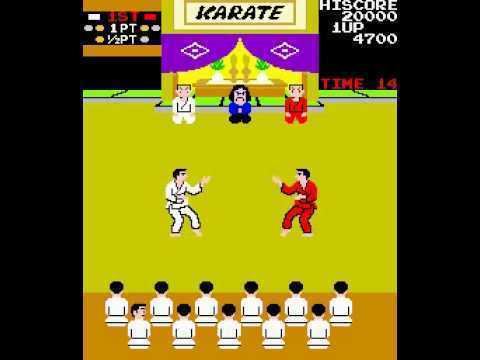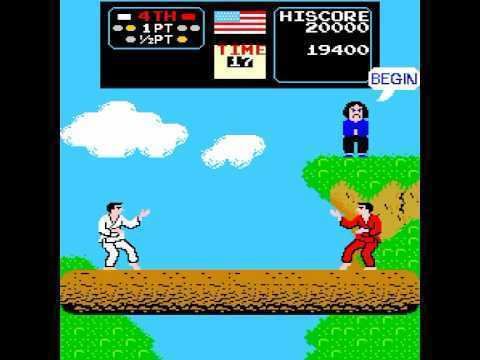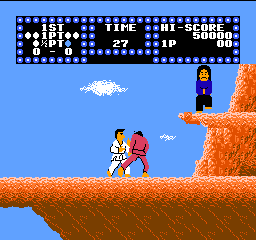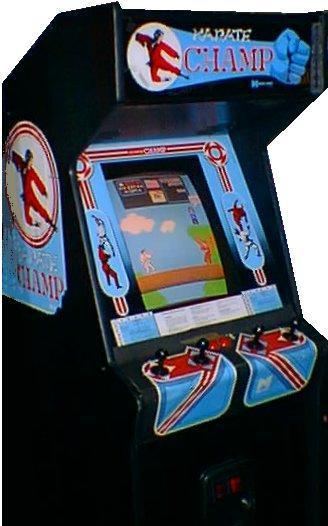8.6 /10 1 Votes8.6
4.1/5 iTunes - Apple Initial release date July 1984 Series Oretachi Gēsen Zoku | 4.6/5 Classic Retro Games Cabinet Upright1 Genre Fighting game | |||||||||||||||||||||||||||||||||
 | ||||||||||||||||||||||||||||||||||
Release date(s) ArcadeJuly 1984Virtual ConsoleJP: March 16, 2010Arcade ArchivesJP: October 9, 2014EU: July 28, 2015NA: September 29, 2015 Mode(s) Up to 2 players simultaneously Display Vertical orientation, Raster, standard resolution (Used: 224 x 256) Platforms Arcade game, Nintendo Entertainment System, Wii, Commodore 64, Family Computer Disk System, iOS, Apple II Similar Oretachi Gēsen Zoku games, Data East games, Fighting games | ||||||||||||||||||||||||||||||||||
Arcade karate champ
Karate Champ, known in Japan as Karate Dō (空手道, "The Way of the Empty Hand"), is a 1984 arcade fighting game developed by Technōs Japan for Data East. It established and popularized the one-on-one fighting game genre. A variety of moves can be performed using the dual-joystick controls, using a best-of-three matches format like later fighting games, and it features training bonus stages. It influenced Konami's Yie Ar Kung Fu and other fighting games.
Contents

A separate game that allows two players the option to compete against each other was released in 1984 under the title Karate Champ — Player vs Player.

Gameplay

The player assumes the role of a karate competitor and fights against another player or the computer. Using two joysticks, players can execute a number of moves.

Gameplay consists of a two dimensional fight between Karate characters wearing white and red gi, followed by various bonus rounds for the successful player. This pattern repeats itself in the next, more challenging round set against a new background. Unlike most later fighter-type games, there are no health bar or hit points. A hit successfully landed ends the round and earns the player or his opponent either one point or half point (along with a numeric score for the top ten but this has no effect on winning a match per se). The first to score two points is the winner. If the player loses a battle, the game ends.
The game features digitized speech for the judge to call out such phrases as "Fight!" or "Winner!" The speech is in Japanese in the Japanese version.
Player vs. Player edition
Karate Champ — Player vs Player (対戦空手道 美少女青春編, Taisen Karate Dō: Bishōjo Seishun Hen, "The Competitive Way of the Empty Hand: Pretty Maiden Edition") is a sequel to Karate Champ that was released for the arcades shortly after the original during the same year. Like its predecessor, it was published by Data East, but it is unclear if it was developed by Technos or by Data East.
The sequel is very similar to the original in the sense that they use the same hardware, have the same sprites and title screen, and the play mechanics are essentially the same although the computer AI and speech quality is greatly improved along with control and hit detection. Whereas the original game started with the first level taking place at a dojo and all the following levels taking place at the same tournament stadium, Player vs Player has the characters fighting it out over girls in 12 different locations around the world. After every second victory, the player has a chance to earn bonus points by dodging or striking targets.
Ports and re-releases
Karate Champ was ported to the Apple II and the Commodore 64 by Berkeley Softworks. Data East began publishing the home versions in the US on October 12, 1985.
The NES version was released in North America on November 1986. Like the home computer versions, the NES port was inspired by the Player vs. Player edition of the arcade game. The port was later released in Japan for the Disk System on July 22, 1988, but never made it to the cartridge-based Family Computer. Data East published this port of the game, both in North America and Japan.
An emulation of the arcade version was released by Hamster for the PlayStation 2 as part of its Oretachi Geasen Zoku Sono lineup. Only the original game was included (the Player vs. Player version being ignored from the compilation).
On May 7, 2010 it was announced for release on the iPhone platform by developer Revolutionary Concepts. Although visually identical to the 1984 arcade edition of Karate Champ — Player vs Player, the iPhone version is actually a remake rather than an emulation, as it includes new features such as a difficulty mode as well as the ability for players to compete through a gaming network via Bluetooth or Wi-Fi. In August 2010, the game was released for the iPad under the title Karate Champ XL, again developed by Revolutionary Concepts. Karate Champ XL is basically the same game as the iPhone's Karate Champ, but with additional attributes over its phone counterpart such as a split screen option.
The emulated version from Hamster was re-released in 2015 for the PlayStation 4 on the Arcade Archives compilation which, unlike Oretachi Geasen Zoku Sono, was officially distributed outside of Japan.
Lawsuit
Publisher Data East brought suit against Epyx alleging copyright infringement for its game World Karate Championship. The case went to the ninth circuit court. It was held that the typical purchaser of the games would not find them substantially similar.
Reception
Ahoy! wrote that the Commodore 64 version "isn't quite as electrifying as the arcade version, but it's an entertaining action-strategy test". The magazine concluded that "The learning curve is steep, but ... When the joysticks are in the hands of two practiced gamers, it is one of the most exciting games to hit the computer screen in a long time."
